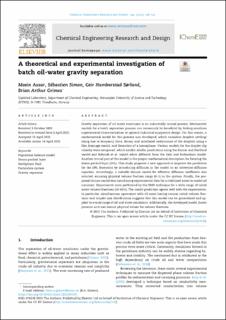| dc.contributor.author | Assar, Moein | |
| dc.contributor.author | Simon, Sebastien Charles Roger | |
| dc.contributor.author | Sørland, Geir | |
| dc.contributor.author | Grimes, Brian Arthur | |
| dc.date.accessioned | 2023-05-15T08:32:14Z | |
| dc.date.available | 2023-05-15T08:32:14Z | |
| dc.date.created | 2023-05-03T16:18:08Z | |
| dc.date.issued | 2023 | |
| dc.identifier.citation | Chemical engineering research & design. 2023, 194 136-150. | en_US |
| dc.identifier.issn | 0263-8762 | |
| dc.identifier.uri | https://hdl.handle.net/11250/3067900 | |
| dc.description.abstract | Gravity separation of oil-water emulsions is an industrially crucial process. Mechanistic models for a batch separation process can immensely be beneficial by linking emulsion experimental characterization to optimal industrial equipment design. For this reason, a mathematical model for this process was developed, which considers droplets settling/ rising due to buoyancy force, binary and interfacial coalescence of the droplets using a film drainage model, and formation of a homophase. Various models for the droplet slip velocity were compared, which exhibit similar predictions using the Kumar and Hartland model and Behzadi et al. model while different from the Zaki and Richardson model. Another crucial part of the model is the proper mathematical description for forming the dense-packed layer (DPL). This study proposes a new approach to improve the prediction for the DPL formation by introducing diffusion in the model as an advection-diffusion equation. Accordingly, a suitable closure model for effective diffusion coefficient was selected, ensuring physical volume fraction range (0−1) in the system. Finally, the proposed closure model was tuned using experimental data for a stabilized water in model oil emulsion. Experiments were performed by the NMR technique for a wide range of initial water volume fractions (20–60%). The model prediction agrees well with the experiments. In particular, simultaneous agreement with all cases having various initial volume fractions and droplet size distributions suggests that this model can be generalized and applied to a wide range of oil and water emulsions. Additionally, the developed model shows promise as it can ensure physical values for volume fractions. | en_US |
| dc.language.iso | eng | en_US |
| dc.publisher | Elsevier | en_US |
| dc.relation.uri | https://www.sciencedirect.com/science/article/pii/S0263876223002411?via%3Dihub | |
| dc.rights | Navngivelse 4.0 Internasjonal | * |
| dc.rights.uri | http://creativecommons.org/licenses/by/4.0/deed.no | * |
| dc.title | A theoretical and experimental investigation of batch oil-water gravity separation | en_US |
| dc.title.alternative | A theoretical and experimental investigation of batch oil-water gravity separation | en_US |
| dc.type | Peer reviewed | en_US |
| dc.type | Journal article | en_US |
| dc.description.version | publishedVersion | en_US |
| dc.source.pagenumber | 136-150 | en_US |
| dc.source.volume | 194 | en_US |
| dc.source.journal | Chemical engineering research & design | en_US |
| dc.identifier.doi | 10.1016/j.cherd.2023.04.029 | |
| dc.identifier.cristin | 2145233 | |
| dc.relation.project | Norges forskningsråd: 237893 | en_US |
| cristin.ispublished | true | |
| cristin.fulltext | original | |
| cristin.fulltext | original | |
| cristin.fulltext | postprint | |
| cristin.fulltext | preprint | |
| cristin.qualitycode | 1 | |

